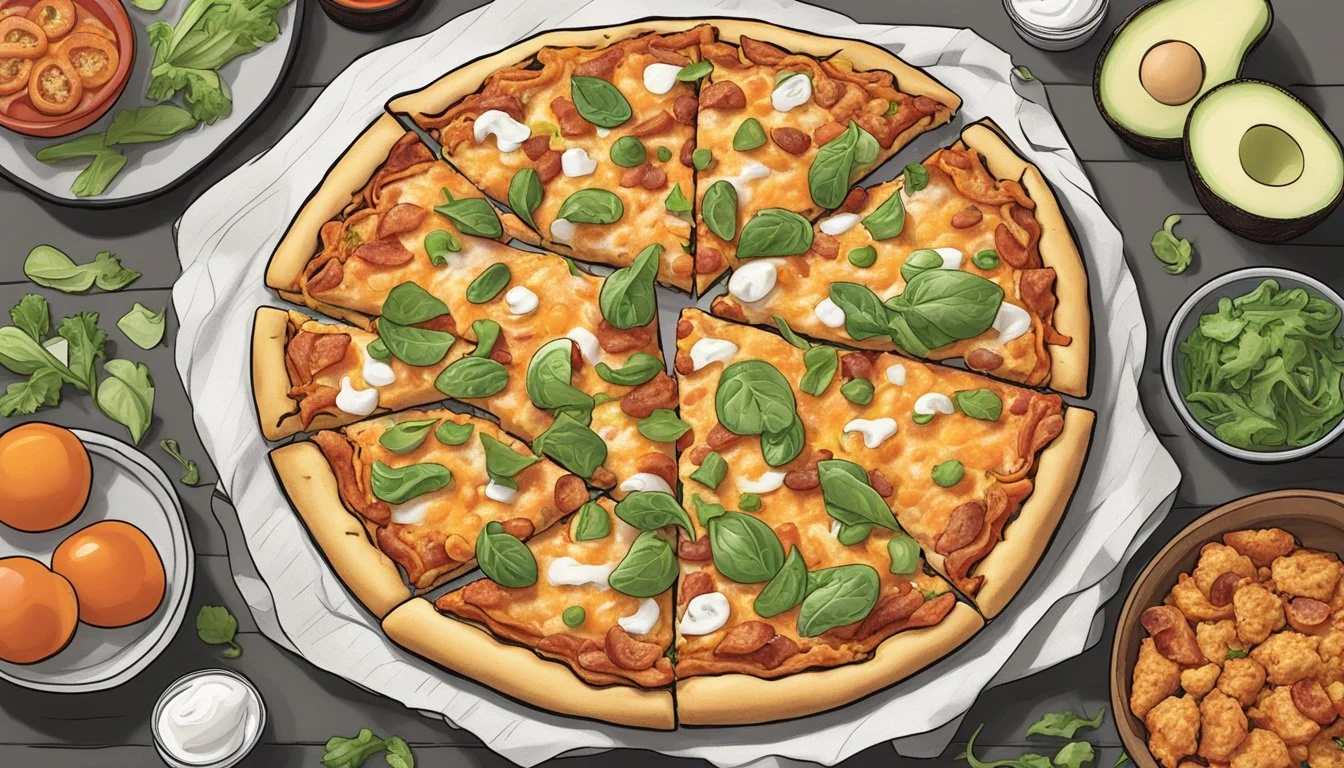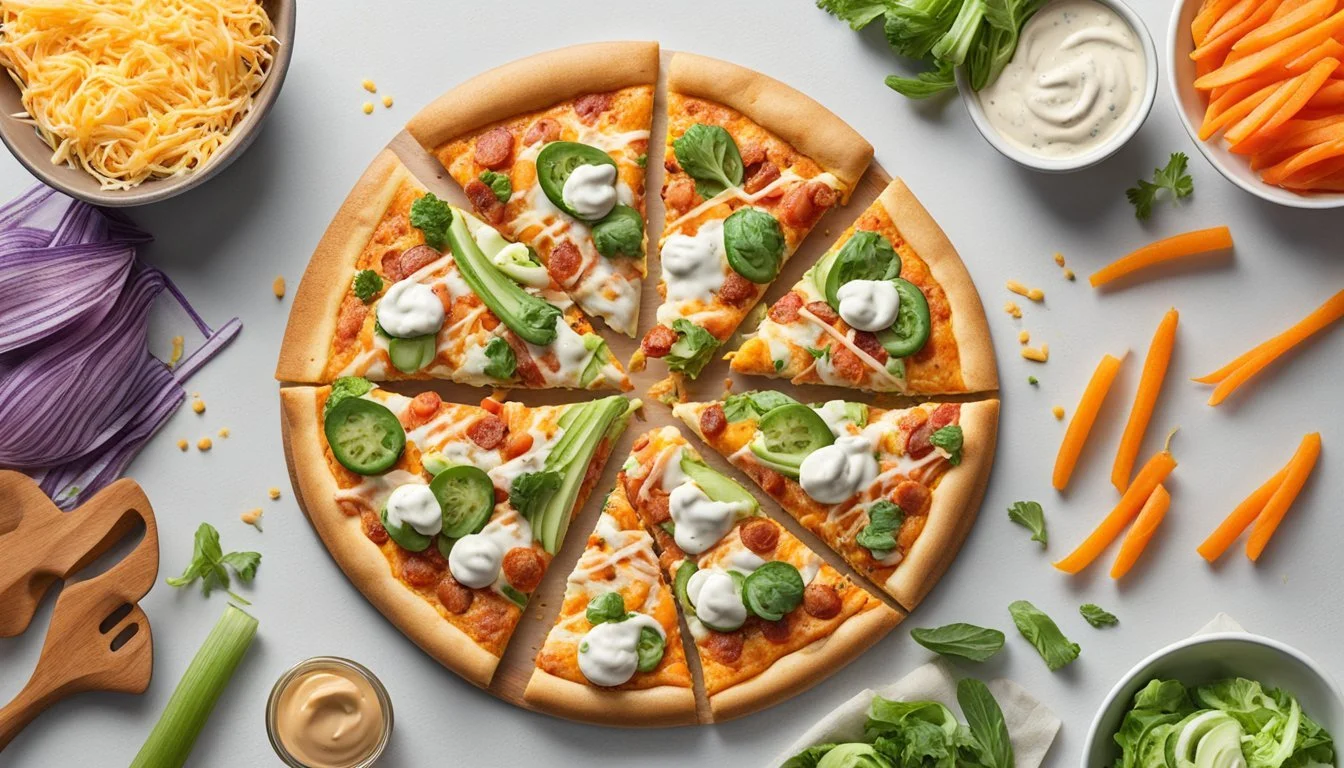Is Buffalo Chicken Bacon Ranch Pizza Vegan?
Debunking Common Myths
When examining the concept of a buffalo chicken bacon ranch pizza, (What wine goes well with pizza?) it's essential to scrutinize each component to assess its compatibility with a vegan diet. At its core, the traditional form of this pizza is not vegan due to the presence of chicken, bacon, and ranch—all of which are animal-derived products. Veganism excludes all forms of animal products, focusing on plant-based alternatives instead.
However, the evolution of vegan cuisine has given rise to countless substitutes that mimic the flavors and textures of meat and dairy products. Vegan buffalo chicken pizza is a testament to this innovation, with plant-based versions of chicken and dairy-free cheeses available on the market. Vegan ranch can also be prepared using non-dairy bases like nuts or soy, combined with herbs and spices to achieve a similar taste profile.
Creating a pizza that embodies the heartiness of buffalo chicken bacon ranch while adhering to vegan principles requires carefully selected ingredients. It entails using animal-free versions of the pivotal elements: vegan chicken substitutes, vegan bacon bits, and vegan cheeses, alongside a dairy-free ranch dressing. Such considerations are crucial for crafting a pizza that aligns with vegan dietary choices without compromising on the essence of the dish.
Understanding Veganism
In exploring the concept of veganism, one must differentiate it from other dietary choices while understanding its core principles. Veganism is marked by strict adherence to plant-based foods and avoidance of all animal products.
What Is Vegan?
Vegan refers to a diet and lifestyle that excludes the consumption of animal products and by-products. Those who follow this lifestyle avoid all forms of meat, dairy, eggs, and honey, as well as products derived from animals such as gelatin and certain additives. Vegan-friendly denotes foods, products, or establishments that cater to vegan dietary requirements. For a product to be vegan-friendly, it must not contain animal ingredients and ideally not be processed using animal-derived substances.
Vegans often seek out whole food options, prioritizing unprocessed or minimally processed plant ingredients. This choice aligns with the health aspect of veganism and its emphasis on dairy-free alternatives, such as plant milks and cheese substitutes made from nuts, seeds, or soy.
Vegan vs. Vegetarian
Vegan:
Excludes all animal products
Avoids secondary animal-derived products (e.g., casein, whey)
Vegetarian:
Excludes meat but may include dairy, eggs, and honey
Often categorized into subsets like lacto-ovo, lacto, and ovo based on what animal products are consumed
The distinction between vegan and vegetarian can be summarized by their varying degrees of animal product exclusion. While both diets share a plant-centric focus, vegetarians may consume dairy or eggs, whereas vegans commit to a completely plant-based regimen that eliminates these items.
Buffalo Chicken Pizza Components
Buffalo chicken bacon ranch pizza is a flavorful dish with several key components that can be modified to suit dietary preferences, including a vegan diet. This section dissects the elements of the pizza that traditionally contain animal products, offering plant-based alternatives to create a vegan version without compromising taste or texture.
Crust Varieties
Traditional Crust: Typically made with flour, water, yeast, and sometimes a small amount of dairy or sugar.
Vegan Options: Can be made without dairy or eggs, using olive oil for richness. Store-bought vegan crusts are widely available.
Vegan Chicken Alternatives
Soy-based: Tofu, tempeh, or textured vegetable protein (TVP) can be seasoned and used as a chicken substitute.
Specialty products: Brands such as Beyond Meat and Gardein offer plant-based chicken alternatives specifically designed to mimic the taste and texture of chicken.
Vegan Cheese Options
Mozzarella-style: Vegan cheese made from nuts, soy, or tapioca blends provide the desired melt and stretch.
Cheddar-style: Available for those who prefer the sharper taste in conjunction with the buffalo sauce.
Buffalo Sauce
Ingredients: Typically combines hot sauce, vinegar, Worcestershire sauce (which is not traditionally vegan due to anchovies), (What wine goes well with anchovies?) butter, or margarine.
Vegan Buffalo Sauce: Ensure Worcestershire sauce is vegan and use plant-based butter or margarine alternatives.
Toppings and Additions
Vegetables: Red onion, green onion, cilantro, and garlic are common toppings that enhance the flavor and are inherently vegan.
Bacon Alternatives: Vegan bacon made from seitan, (What wine goes well with seitan?) coconut, or other plant materials can be used to replicate the bacon element in the pizza.
Ranch Dressing: Vegan versions can be made using plant-based mayonnaise, dairy-free sour cream, and traditional herb blends.
It's critical when creating a vegan buffalo chicken pizza to carefully select each component, ensuring that each is truly plant-based while also providing the intended flavor and texture experience.
Vegan Pizza Dough Recipe
Crafting homemade vegan pizza dough is a straightforward process that does not involve animal products. It revolves around simple ingredients and methods that ensure a crispy yet chewy pizza base ideal for a variety of toppings.
Ingredients
2 1/4 teaspoons active dry yeast
1 teaspoon sugar (to activate the yeast)
1 1/2 cups warm water (approximately 110°F, warm but not hot to the touch)
3 1/2 cups all-purpose flour (can substitute with gluten-free flour if desired)
1 tablespoon olive oil (plus more for coating)
2 teaspoons salt
1/2 teaspoon garlic powder (optional, for flavor)
Preparation Steps
In a small bowl, combine the warm water, sugar, and yeast. Let the mixture sit for about 5 minutes until it becomes frothy, indicating that the yeast is active.
In a large mixing bowl, whisk together the flour, salt, and garlic powder if using. Create a well in the center.
Once the yeast mixture is ready, pour it along with the olive oil into the center of the flour mixture.
Mix with a fork or your hands until a shaggy dough begins to form. Then, transfer the dough onto a clean, floured surface.
Knead the dough for about 5-7 minutes until it's smooth and elastic. If the dough is too sticky, add a little more flour as needed.
Coat a clean bowl with olive oil, place the dough inside, and turn to coat. Cover the bowl with a damp cloth or plastic wrap and let it rise in a warm place until it doubles in size, approximately 1 to 1.5 hours.
Once risen, punch down the dough to release air bubbles, and it's ready to use. If not using immediately, the dough can be refrigerated for up to 24 hours or frozen for future use.
This recipe provides the foundation for a variety of vegan pizzas, including those topped with plant-based cheeses and meat alternatives, suitable for anyone wanting to enjoy pizza adhering to whole foods plant-based principles.
Creating Vegan Ranch Dressing
Vegan ranch dressing recreates the creamy texture and tangy flavor of traditional ranch without any animal products. To achieve this, the dressing relies on plant-based ingredients and a blending process.
Ingredients for Vegan Ranch
When gathering ingredients for vegan ranch, one should include:
Unsweetened plant milk: A base for the "buttermilk" effect.
Apple cider vinegar: To create the buttermilk tang by curdling the plant milk.
Vegan mayo: It provides creaminess to the dressing.
Vegan sour cream: For added richness (optional).
Garlic: Minced or powdered for a savory note.
Onion powder: For depth of flavor.
Dill: Fresh or dried to add a characteristic ranch herb.
Chives: For a mild oniony taste.
Nutritional yeast: To impart a cheesy, umami flavor.
Raw cashews: Soaked and blended for smoothness (substitute if using vegan mayo and sour cream).
Black pepper: Freshly ground for seasoning.
Salt: To taste.
A simple combination of these ingredients can create a delicious dressing that's completely vegan-friendly.
Blending the Ranch
The blending technique is crucial for achieving the right consistency:
Start by curdling the plant milk with apple cider vinegar. This step should take a few minutes.
Soak raw cashews in hot water if they are being used instead of or in addition to vegan mayo and sour cream. After soaking, drain them.
Place the curdled plant milk, soaked cashews (if using), vegan mayo, vegan sour cream (optional), garlic, onion powder, nutritional yeast, and other seasonings into the blender.
Blend until the mixture is smooth and creamy. For a thinner dressing, one can add more plant milk; for a thicker dip-like consistency, use less liquid.
Finish by pulsing in the herbs like dill and chives to keep their texture and flavor pronounced.
Through these steps, one can achieve a vegan ranch dressing that rivals the taste and creaminess of traditional ranch, while aligning with vegan dietary preferences.
Assembling the Pizza
Crafting the perfect vegan buffalo chicken bacon ranch pizza involves precise layering, careful baking methods, and the right finishing touches. Attention to detail ensures that each slice is bursting with flavor while adhering to vegan standards.
Layering the Ingredients
Start by preheating your oven—a critical step to achieve an evenly cooked pizza with a crisp crust. For standard ovens, aim for a temperature around 425°F (220°C). If using a pizza stone, place it in the oven during the preheating stage.
Once the oven is ready, prepare your baking sheet or pizza pan by lightly coating it with extra virgin olive oil. If you're using a pizza stone, prepare a pizza peel with a dusting of flour or cornmeal to easily slide the pizza onto the stone.
Now, roll your pizza dough into a 12-14 inch diameter on a clean, lightly floured surface (gluten-free dough can be used for those with gluten sensitivities). Transfer the rolled dough onto your chosen baking surface.
Begin by spreading ranch sauce on the dough, leaving a margin at the edges for the crust. Next, evenly distribute the vegan buffalo chicken pieces, followed by a generous sprinkle of vegan bacon bits. Top everything with vegan mozzarella shreds, ensuring ample coverage for an ooey-gooey experience.
Baking Methods
Place the prepared pizza on the middle rack if using a baking sheet or pan. For pizza stone users, slide the pizza onto the stone using the peel. Bake for 13-15 minutes or until you notice the crust turning golden brown and the vegan mozzarella cheese has melted to perfection.
Keep a close eye on the pizza, as baking times may vary depending on oven type and whether the pizza is on a stone, pan, or baking sheet. The goal is a pizza that's baked evenly with a crisp base and well-melted toppings.
Finishing Touches
After baking, carefully remove the pizza from the oven and allow it to cool slightly on a rack. Drizzle melted vegan butter over the top to add a rich, buttery flavor and sprinkle with sea salt for an extra flavor pop.
Optionally, for an additional layer of flavor and moisture, a light drizzle of non-dairy milk or ranch can be added. Slice the pizza into equal portions, serve immediately, and enjoy your vegan culinary masterpiece.
Alternative Vegan Meat Options
The market offers a variety of vegan meat alternatives suitable for replicating the distinctive taste and texture of a buffalo chicken bacon ranch pizza. Exploring these options can lead to satisfying plant-based versions of this beloved pizza variant.
Plant-Based Meat Substitutes
Vegan Chicken: A staple in vegan cuisines, plant-based chicken substitutes are made primarily from soy, wheat gluten, or pea protein. Options such as seitan, a wheat gluten-based meat alternative, has a meaty texture ideal for mimicking the chew of chicken. For those looking for a soy-based product, soy curls, once hydrated and seasoned, can offer a similar bite and are excellent for absorbing the tangy flavors of buffalo sauce.
Vegan Bacon: Vegan bacon choices have proliferated, with brands crafting strips from a mixture of plant proteins, often utilizing liquid smoke and umami-rich seasonings to replicate bacon's flavor profile. These products are designed to provide the crispness and savoriness expected of traditional bacon.
Homemade Vegan Meats
Creating vegan meat at home allows for customization of flavors and textures tailored to personal preferences. For homemade vegan chicken, ingredients like tofu, chickpeas, or vital wheat gluten can be used:
Tofu: It provides a neutral base that can be marinated and baked or fried to create a chewy texture. Marinades with garlic, paprika, and nutritional yeast help achieve the desired savory profile.
Chickpeas:
Whole Cooked Chickpeas: They offer a hearty texture and are excellent for rustic, shredded meat substitutes once mashed or pulsed in a food processor.
Chickpea Flour: Also known as gram flour, it can be used to make seitan-like mixtures or chickpea tofu, which is a versatile base for vegan meat recipes.
By incorporating these plant-based meat substitutes, a buffalo chicken bacon ranch pizza can be enjoyed within a vegan diet without compromising on flavor or texture.
Health and Nutrition
In assessing the health and nutrition of buffalo chicken bacon ranch pizza, particularly when vegan, one must consider its caloric content, macronutrient balance, and micro-nutrient richness. Vegan alternatives can shift these factors considerably compared to traditional recipes.
Caloric Content
Buffalo chicken bacon ranch pizza, especially when prepared vegan, has a caloric profile that varies with ingredients used. A typical slice of this pizza may range from 200 to 300 calories, depending on the choice of crust, vegan cheeses, and meat substitutes. Whole food ingredients and homemade sauces may reduce additives and excess oils, often lowering the caloric density.
Macronutrients
Buffalo chicken bacon ranch pizza as a vegan dish primarily provides carbohydrates from the crust, proteins from plant-based chicken substitutes, and fats from vegan cheeses and dressings.
Proteins: Vegan chicken is typically crafted from soy or wheat gluten, offering about 10 to 20 grams per serving.
Fats: Vegan cheeses and ranch dressings, often made from nuts or soy, contribute to the fat content, which can vary from 5 to 15 grams per slice.
Carbohydrates: A standard pizza crust contributes 20 to 40 grams of carbohydrates, largely influenced by the choice of flour and crust thickness.
Micro-Nutrient Considerations
When the pizza components are selected carefully, the dish can serve as a source of several micronutrients.
Vitamins: Nutritional yeast, a common vegan cheese base, can provide B-vitamins.
Minerals: Toppings like vegetables and vegan meat substitutes may offer iron and potassium.
However, it is essential to be aware that some vegan products may lack in certain micro-nutrients found abundantly in their animal-derived counterparts, such as vitamin B12, unless fortified. Choosing whole food options where feasible can help enhance the nutritional profile.
Serving Suggestions
When serving vegan buffalo chicken pizza, one can elevate the dining experience by pairing it with perfectly selected sides and beverages that complement its spicy and savory flavors.
Complementary Sides
For an enhanced meal, diners might consider adding sides that provide a cooling contrast or additional textures:
Arugula Salad: A simple arugula salad with a squeeze of lime and a drizzle of olive oil can add a fresh, peppery bite that balances the spiciness of the pizza.
Roasted Cauliflower: Lightly seasoned cauliflower, roasted to perfection, pairs well with the robust flavors and adds a satisfying crunch.
Kale and Avocado Salad: Kale tossed with chunks of ripe avocado, sprinkled with green onions and fresh cilantro, brings a creamy and earthy side to the table.
Garnishes: A sprinkle of parsley or red onion on top of the pizza can add a fresh dimension to each bite.
Appropriate Beverages
Selecting the right beverage can enhance the pizza's bold flavors, offering a more complete taste experience:
Sparkling Water: The effervescence of sparkling water can cleanse the palate between spicy mouthfuls.
Herbal Iced Tea: An iced tea infused with herbs like mint or lemon balm can provide a refreshing counterbalance to the heat of the pizza.
Storage and Reheating
Proper storage and reheating of buffalo chicken bacon ranch pizza ensure that the pizza retains its flavor and texture. The following subsections provide specific tips for refrigerating, freezing, and reheating.
Refrigeration Tips
To refrigerate buffalo chicken bacon ranch pizza, one should place the pizza in an airtight container or wrap it tightly with plastic wrap. It's best to refrigerate the pizza within two hours of baking to maintain optimal freshness. The pizza should be consumed within three to four days to enjoy its quality. Always perform a quick review of the pizza before eating to check for any signs of spoilage.
Freezing the Pizza
Freezing the pizza helps extend its shelf life. To freeze, one should:
Cool the pizza completely before freezing to prevent ice crystal formation.
Cut the pizza into portions if desired for easier reheating later.
Wrap the slices individually with plastic wrap, followed by aluminum foil.
Store in airtight containers or freezer bags.
The pizza can be frozen for up to two months. Label the container with the date to keep track of how long it has been stored.
Reheating Without Dryness
To reheat the pizza without it becoming dry, one should:
Preheat the oven to 375°F (190°C).
Place the pizza on a baking sheet lined with parchment paper for even heating.
For a softer crust, cover the pizza with aluminum foil.
Reheat for about 10-15 minutes, checking frequently as ovens may vary.
For individual slices, a toaster oven works effectively and saves energy.
Using these methods will help maintain the moistness and flavor of the pizza after reheating.
Recipe Variations
Adapting a buffalo chicken bacon ranch pizza to a plant-based diet allows for a range of variations to suit differing taste preferences and dietary needs. Below, the reader will find ways to adjust the spiciness, explore different toppings, and select from a variety of crusts to tailor this vegan pizza to their liking.
Spiciness Adjustments
For those who prefer a milder experience, the amount of hot sauce in the spicy buffalo sauce can be reduced. Vegan ranch dressing can be increased to balance the zing without sacrificing flavor. Conversely, individuals can amplify the heat by adding more pepper or choosing a hotter variety of hot sauce.
Mild: Reduce hot sauce by half and double the vegan ranch dressing.
Medium: Use the recommended amounts in the recipe.
Hot: Add an extra tablespoon of hot sauce and a pinch of cayenne pepper.
Topping Combinations
The classic components such as vegan bacon, vegan mozzarella shreds, and Daiya can be complemented with additional ingredients. Incorporate a tang with vegan sour cream, or add a touch of zest with a sprinkle of garlic powder. Each topping offers a unique textural element and enhances the overall flavor profile of the pizza.
Classic: Vegan bacon, vegan mozzarella, and a drizzle of ranch.
Tex-Mex: Add jalapeños and vegan sour cream for a southwestern twist.
Gourmet: Pair with sun-dried tomatoes and arugula for a more refined flavor.
Crust Alternatives
A switch in the crust can transform the pizza’s base from traditional to inventive. Use a thin and crispy crust for those who enjoy a lighter bite, or opt for a whole wheat crust for a hearty texture. Gluten-free options are also available for those with dietary restrictions.
Traditional: Use a classic hand-tossed dough.
Thin Crust: Choose a pre-made thin crust for a crunchier texture.
Gluten-Free: Select a gluten-free base for those with sensitivities.
Final Thoughts
In this section, we dissect the essentials of vegan buffalo chicken pizza and offer encouragement to those considering creating this novel dish.
Summary of Vegan Buffalo Chicken Pizza
Vegan buffalo chicken pizza masterfully substitutes animal-based ingredients with plant-derived alternatives to recreate the savory, piquant flavors of a classic pizza loved by many. The recipe card for this vegan delight usually details a list of vegan dough, vegan cheeses (such as mozzarella and cheddar alternatives), meat substitutes like seasoned and sautéed vegan chicken (commonly made from seitan, soy curls, or other plant proteins), and a richly spiced buffalo sauce. Final touches often include vegan bacon bits and a dairy-free ranch drizzle, elevating the pizza to a sumptuous fusion of textures and flavors that respect vegan dietary choices.
Encouragement to Try Recipe
For those considering vegan recipes or seeking to diversify their culinary repertoire, crafting a vegan buffalo chicken pizza provides an excellent adventure into plant-based cuisine. One experiences the familiar comfort of pizza while engaging with innovative substitutions. The culinary process itself can be a learning journey, introducing chefs to new techniques and ingredients that uphold vegan ethics without compromising on taste.












